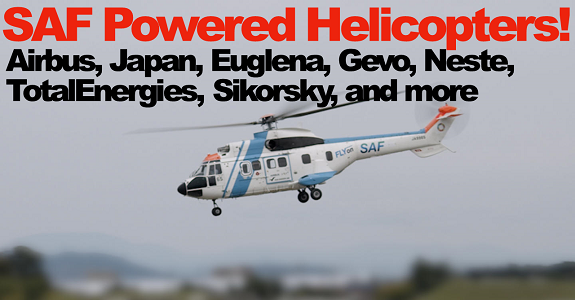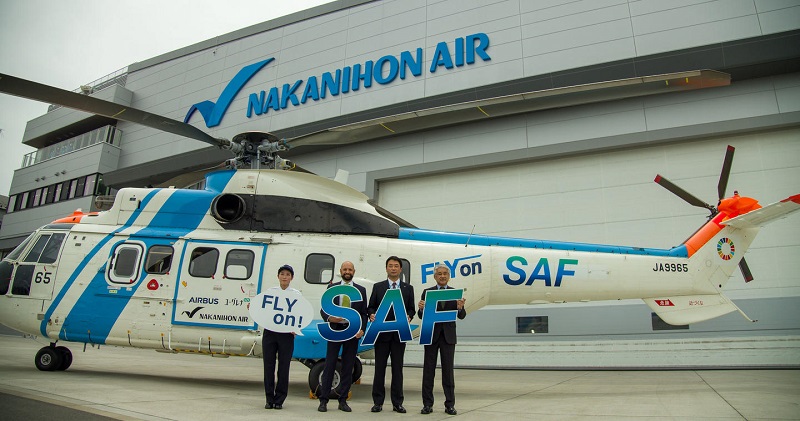SAF flying high on helicopters! Japan’s first SAF helicopter flight

We’ve talked about sustainable aviation fuel so much in regards to airplanes, but how about helicopters? Well, news came in that Airbus Helicopters in Japan and Japan’s leading helicopter operator Nakanihon Air (NNK) jointly performed the country’s first ever helicopter flight powered with sustainable aviation fuel. So this made us look at SAF and helicopters in a whole new way.
In today’s Digest, details on this Airbus Helicopter SAF flight, reactions from the stakeholders, other recent helicopter biofuel and SAF highlights from big names, who’s making the SAF, who’s using it, and more.
Hello Helicopter!
Let’s start with the Airbus Helicopter. Japan’s leading helicopter operator Nakanihon Air (NNK)’s H215 helicopter conducted a 30-minute SAF flight at Nagoya Airport in Aichi Prefecture. The twin-engine, heavy-lift H215 is a member of the Super Puma helicopter family, known for its high availability rate, performance, and competitive operating cost.
This kind of helicopter is powered by a pair of Turbomeca Makila 1A1 turboshaft engines, the rotorcraft is outfitted with cutting-edge technology, a large reconfigurable cabin, a wide range of equipment options, a night vision goggle-compatible cockpit, and an all-weather capability that includes a full de-icing system. The multi-role aircraft can perform a variety of tasks and be used in different missions, including law enforcement, passenger transport, firefighting, and disaster relief.
Today, all Airbus helicopters are certified to fly with up to a 50% blend of SAF mixed with kerosene, with the aim to reach 100% SAF in coordination with engine manufacturers. An Airbus H225 performed the first ever helicopter flight with 100% SAF powering one of the Safran Makila 2 engines in 2021. Helicopter operations with 100% SAF would translate to a reduction of 80% of CO2 emissions.
What was the fuel? Who made it?
The aircraft was fueled with 600 litres of “SUSTEO 10”, a renewable jet fuel produced by Japan’s first biofuel manufacturer Euglena, which has met the specifications of both international and Japanese standards of diesel fuels ASTM D1655 and JIS K 2204 respectively. SUSTEO contains 10% of SAF mixed with Jet A-1.
Reactions from the stakeholders
“We are happy to collaborate with Airbus Helicopters in Japan and Euglena on sustainability efforts for Japan’s sky, achieving the first SAF helicopter flight together,” said Hajime Futagami, President of Nakanihon Air. “Today’s SAF flight trial is very important for our company as we work on the reduction of the CO2 emitted during flights in an effort to tackle climate change issues. The locally produced SAF is an immediate approach towards reducing carbon emissions for the helicopter market. We are looking forward to the continued support from Airbus on our wide-ranging activities in Japan, with the enhanced precision and stability we require,” he added.
“We are pleased to launch this milestone SAF flight together with our long-standing customer as we work towards decarbonisation,” said Guillaume Leprince, Managing Director of Airbus Helicopters in Japan. “As a leader in the Japanese helicopter market, this SAF powered flight is an important step in a shared vision we have with stakeholders in the helicopter market and the industry to reduce CO2 emissions in the country. The H215 has fully demonstrated its ability and readiness to provide enhanced mission efficiency and performance our customers have come to expect.”

SAF in Helicopters Not New
While this news is exciting for Airbus and Japan, it’s not exactly the first time SAF has been used on helicopters.
Going back all the way to 2011, the U.S. Navy used Solazyme’s 100% algal-derived jet fuel, Solajet HRJ-5, in an MH-60S Seahawk helicopter test flight in a 50/50 blend with petroleum-derived jet fuel. Honeywell UOP was the refining partner on the jet fuel delivery, and had been working with Solazyme since 2009 on multiple contracts with the US military. At that time, Solazyme was the only company to provide the US Navy with microbially-derived advanced aviation and marine fuel.
Even Gevo got in on the action with the U.S. Army trialing Gevo’s isobutanol in a 50/50 blend in a Black Hawk helicopter in Alabama in 2013. The announcement was delayed due to a $23 million fundraising round. The isobutanol was produced at the Gevo facility in Lucerne and converted into jet fuel at the company’s facility in Silsbee, Texas.
2021 was a pretty good year for SAF in helicopters, like in June 2021, The Digest reported that in Germany, a rescue helicopter flew on SAF for the first time, achieving a new milestone in international aviation. Operated by the German non-profit organization ADAC Luftrettung, the Airbus H145 rescue helicopter has its Arriel 2E engines ceremonially refueled with biofuel at the air rescue station at Munich’s Harlaching Clinic in the presence of the ADAC Foundation’s board of directors, as well as the managing directors and top management of ADAC Luftrettung, the engine manufacturer Safran Helicopter Engines, the helicopter manufacturer Airbus Helicopters, and the energy company TotalEnergies. Together, these companies will be a driving force in the decarbonization of helicopter flight by moving away from fossil fuels. The biofuel used for the first rescue helicopter flight in Munich was produced by TotalEnergies at its refinery in Normandy from used cooking oil.
Also last year, in Connecticut, Sikorsky, a Lockheed Martin Company, approved the use of SAF for the S-92 helicopter as an alternative to petroleum-based fuels and the aircraft completed its first flight. CHC Helikopter Service of Norway, was the first to fly the S-92 helicopter using Synthetic Paraffinic Kerosene (HEFA-SPK) which is one of seven types of approved SAFs available today. HEFA-SPK is produced from waste and residual feedstock such as used cooking oil.
And just a few weeks ago, Finland-based Helsinki Citycopter committed to using a 38% SAF blend in first transition phase at Helsinki-Vantaa airport on its ACH130s helicopters. They are using Neste MY Sustainable Aviation Fuel.
Bottom Line
It makes sense that in the early days, SAF was tested in helicopters by the military, considering the sheer number of helicopters they have, but now it’s becoming a little more widespread. Perhaps not as common as SAF in commercial aviation, but as we saw with shipping, all it takes is a few big guys pushing it forward to make it into the market even more, so we see this as just the beginning of SAF in helicopters.
In fact, Airbus Helicopters launched a SAF User Group dedicated to the rotary-wing community, in a bid to drive the deployment of biofuels. The company has also started using SAF for training and test flights at its French and German sites. So stay tuned for more hot helicopter SAF news in the near future.
Category: Top Stories















